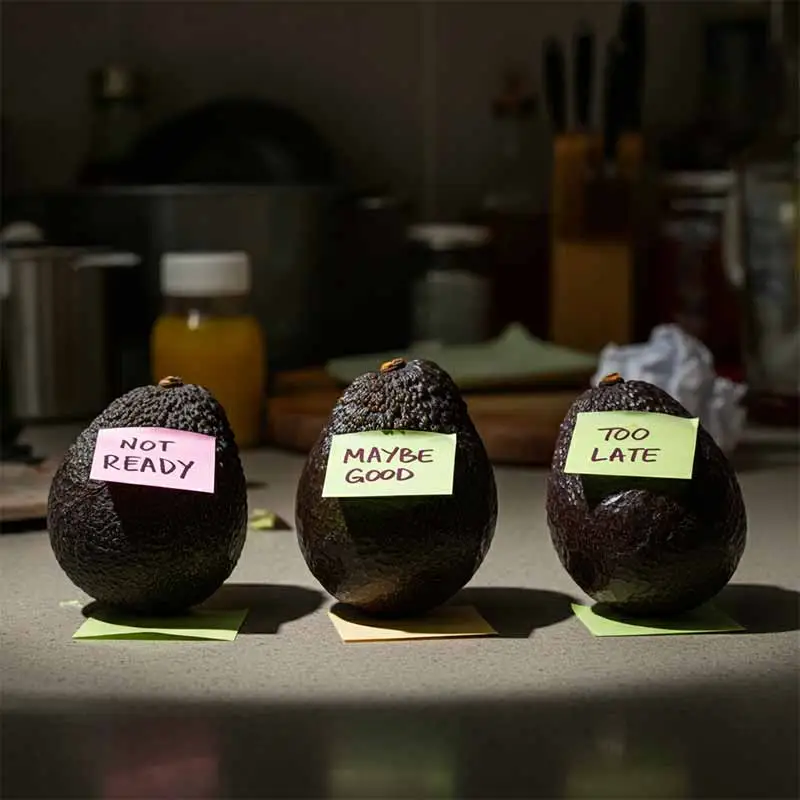Learning how to pick a ripe avocado is essential for anyone who loves this versatile fruit.
Whether you’re planning to make guacamole, avocado toast, or simply enjoy it sliced, knowing how to choose the right avocado can make all the difference.
According to California Avocado Commission, a perfectly ripe avocado enhances both flavor and texture in dishes.
1. Check the Skin Color
The skin color of an avocado can give you a good indication of its ripeness. Here’s what to look for:
- Dark, almost black skin: This suggests the avocado is ripe or very close to being ripe. If the avocado also yields slightly to gentle pressure, it’s ready to eat.
- Green skin: Avocados with a lighter green skin are typically underripe and will require a few more days to ripen.
2. Feel the Firmness
Gently squeeze the avocado without applying too much pressure, as this can cause bruising. The texture of the avocado can tell you a lot about its ripeness:
- Soft but firm: A ripe avocado will give slightly when squeezed but still feel firm. This is ideal for immediate consumption.
- Mushy or very soft: This indicates that the avocado is overripe, and it may have brown spots inside.
- Very hard: If the avocado is too firm, it is not ripe yet and will need some time to ripen at home.
3. Examine the Stem
The small stem or cap at the top of the avocado can be a great indicator of its ripeness:
- If the stem comes off easily and is green underneath: The avocado is ripe and ready to eat.
- If the stem is difficult to remove or if it’s brown underneath: This suggests that the avocado is either underripe or overripe.
If you’re interested in other fresh ingredients, explore these sourdough discard recipes.
4. Look for Even Texture and Skin Condition
Inspect the skin of the avocado for any irregularities:
- Consistent texture: Choose avocados that have an even texture all around, avoiding any that have deep indentations or soft spots.
- No blemishes or cracks: A good avocado should have smooth skin without any significant blemishes, cracks, or deep cuts.
5. Weight Test
Lift different avocados of similar size to gauge their weight:
- Heavier avocados: These usually have a higher water content and are likely to be more creamy and ripe.
6. Avoid Avocados with Sunken Areas or Dark Spots
Avocados with visible sunken areas, dark spots, or wrinkled skin are likely past their prime. These signs often indicate internal bruising or over-ripeness, which can affect both the flavor and texture of the avocado.
7. Consider the Avocado Variety
Different varieties of avocados ripen differently:
- Hass Avocados: The most common variety, which turns dark green to purplish-black as it ripens.
- Florida Avocados: Larger and remain green even when ripe, so focus more on feel than color for these.
Learn about making the perfect dish with our cottage cheese bread recipe to complement your avocado-based meals.
For more detailed information on avocado ripening, you can check out this guide by Harvard T.H. Chan School of Public Health.
Frequently Asked Questions
Do avocados continue to ripen after being picked?
Yes, avocados ripen after they are harvested, which means you can buy them underripe and let them mature at home.
How can I speed up the ripening process?
To ripen avocados faster, place them in a paper bag with a banana or apple. The ethylene gas emitted by these fruits will help speed up the ripening process.
How should I store ripe avocados?
If your avocado is ripe but you’re not ready to use it, store it in the refrigerator. This will slow down the ripening process and extend its freshness for a few more days.
By following these guidelines, you’ll always have a perfectly ripe avocado on hand, ready to add a creamy, delicious touch to your meals.

1 thought on “How to Pick a Ripe Avocado: Simple Tips for Perfect Avocados”